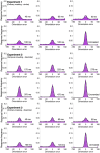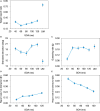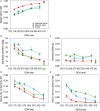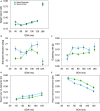Interference across time: dissociating short from long temporal interference
- PMID: 39114585
- PMCID: PMC11305178
- DOI: 10.3389/fpsyg.2024.1393065
Interference across time: dissociating short from long temporal interference
Abstract
Our ability to identify an object is often impaired by the presence of preceding and/or succeeding task-irrelevant items. Understanding this temporal interference is critical for any theoretical account of interference across time and for minimizing its detrimental effects. Therefore, we used the same sequences of 3 orientation items, orientation estimation task, and computational models, to examine temporal interference over both short (<150 ms; visual masking) and long (175-475 ms; temporal crowding) intervals. We further examined how inter-item similarity modifies these different instances of temporal interference. Qualitatively different results emerged for interference of different scales. Interference over long intervals mainly degraded the precision of the target encoding while interference over short intervals mainly affected the signal-to-noise ratio. Although both interference instances modulated substitution errors (reporting a wrong item) and were alleviated with dissimilar items, their characteristics were markedly disparate. These findings suggest that different mechanisms mediate temporal interference of different scales.
Keywords: interference; mixture-model analysis; similarity; temporal crowding; visual masking.
Copyright © 2024 Hochmitz, Abu-Akel and Yeshurun.
Conflict of interest statement
The authors declare that the research was conducted in the absence of any commercial or financial relationships that could be construed as a potential conflict of interest.
Figures








Similar articles
-
Temporal crowding is a unique phenomenon reflecting impaired target encoding over large temporal intervals.Psychon Bull Rev. 2021 Dec;28(6):1885-1893. doi: 10.3758/s13423-021-01943-8. Epub 2021 Jun 2. Psychon Bull Rev. 2021. PMID: 34080137
-
Temporal crowding with central vision reveals the fragility of visual representations.J Exp Psychol Gen. 2024 Feb;153(2):339-351. doi: 10.1037/xge0001496. Epub 2023 Nov 13. J Exp Psychol Gen. 2024. PMID: 37956076
-
Interference between items stored for distinct tasks in visual working memory.Atten Percept Psychophys. 2023 Jul;85(5):1461-1473. doi: 10.3758/s13414-023-02657-w. Epub 2023 Jan 31. Atten Percept Psychophys. 2023. PMID: 36720779 Free PMC article.
-
Escaping the recent past: which stimulus dimensions influence proactive interference?Mem Cognit. 2013 Jul;41(5):650-70. doi: 10.3758/s13421-012-0287-0. Mem Cognit. 2013. PMID: 23297049 Free PMC article.
-
Perceptual Errors Support the Notion of Masking by Object Substitution.Perception. 2019 Feb;48(2):138-161. doi: 10.1177/0301006619825782. Perception. 2019. PMID: 30799730
References
-
- Bevan W., Jonides J., Collyer S. C. (1970). Chromatic relationships in metacontrast suppression. Psychon. Sci. 19, 367–368. doi: 10.3758/BF03328863 - DOI
LinkOut - more resources
Full Text Sources

